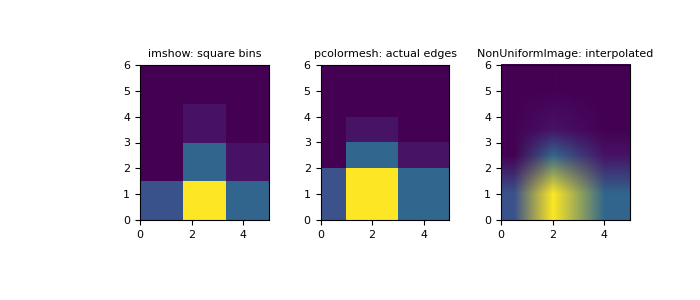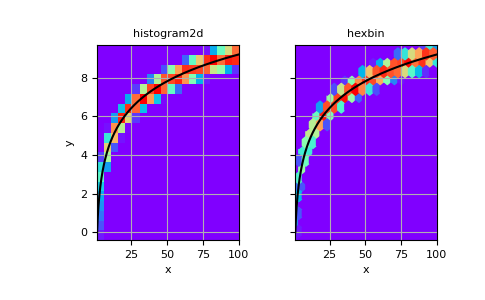numpy.histogram2d #
- 麻木的。histogram2d ( x , y , bins = 10 , range = None , Density = None , Weights = None ) [来源] #
计算两个数据样本的二维直方图。
- 参数:
- x类似数组,形状 (N,)
包含要绘制直方图的点的 x 坐标的数组。
- y类似数组,形状 (N,)
包含要绘制直方图的点的 y 坐标的数组。
- bins int 或 array_like 或 [int, int] 或 [array, array],可选
料仓规格:
如果是 int,则为二维的 bin 数量 (nx=ny=bins)。
如果是 array_like,则为二维的 bin 边缘 (x_edges=y_edges=bins)。
如果为 [int, int],则为每个维度中的 bin 数量 (nx, ny = bins)。
如果为 [array, array],则每个维度中的 bin 边缘 (x_edges, y_edges = bins)。
组合 [int, array] 或 [array, int],其中 int 是 bin 数量,array 是 bin 边缘。
- 范围array_like,形状(2,2),可选
沿每个维度的 bin 的最左边缘和最右边缘(如果未在bin参数中明确指定): 。在此范围之外的所有值都将被视为异常值,并且不会在直方图中进行统计。
[[xmin, xmax], [ymin, ymax]]- 密度bool,可选
如果为 False(默认值),则返回每个 bin 中的样本数。如果为 True,则返回bin 处的 概率密度函数。
bin_count / sample_count / bin_area- 权重array_like,形状(N,),可选
w_i对每个样本进行称重的一组值。如果密度为 True,则权重标准化为 1 。如果密度为 False,则返回的直方图的值等于属于每个 bin 的样本的权重之和。(x_i, y_i)
- 返回:
- H ndarray,形状(nx,ny)
样本x和y的二维直方图。x中的值 沿第一个维度绘制直方图,y中的值沿第二个维度绘制直方图。
- xedges ndarray,形状(nx+1,)
箱沿第一维度边缘。
- yedges ndarray,形状(ny+1,)
箱沿第二维边缘。
也可以看看
histogram一维直方图
histogramdd多维直方图
笔记
当密度为 True 时,返回的直方图是样本密度,其定义是使产品的 bin 总和 为 1。
bin_value * bin_area请注意,直方图不遵循笛卡尔约定,其中x值位于横坐标,y值位于纵坐标。相反,x沿数组的第一维(垂直)绘制直方图,y沿数组的第二维(水平)绘制直方图。这确保了与 的兼容性
histogramdd。例子
>>> from matplotlib.image import NonUniformImage >>> import matplotlib.pyplot as plt
构建具有可变 bin 宽度的二维直方图。首先定义 bin 边缘:
>>> xedges = [0, 1, 3, 5] >>> yedges = [0, 2, 3, 4, 6]
接下来我们创建一个包含随机 bin 内容的直方图 H:
>>> x = np.random.normal(2, 1, 100) >>> y = np.random.normal(1, 1, 100) >>> H, xedges, yedges = np.histogram2d(x, y, bins=(xedges, yedges)) >>> # Histogram does not follow Cartesian convention (see Notes), >>> # therefore transpose H for visualization purposes. >>> H = H.T
imshow只能显示方形 bin:>>> fig = plt.figure(figsize=(7, 3)) >>> ax = fig.add_subplot(131, title='imshow: square bins') >>> plt.imshow(H, interpolation='nearest', origin='lower', ... extent=[xedges[0], xedges[-1], yedges[0], yedges[-1]]) <matplotlib.image.AxesImage object at 0x...>
pcolormesh可以显示实际边缘:>>> ax = fig.add_subplot(132, title='pcolormesh: actual edges', ... aspect='equal') >>> X, Y = np.meshgrid(xedges, yedges) >>> ax.pcolormesh(X, Y, H) <matplotlib.collections.QuadMesh object at 0x...>
NonUniformImage可用于通过插值显示实际的 bin 边缘:>>> ax = fig.add_subplot(133, title='NonUniformImage: interpolated', ... aspect='equal', xlim=xedges[[0, -1]], ylim=yedges[[0, -1]]) >>> im = NonUniformImage(ax, interpolation='bilinear') >>> xcenters = (xedges[:-1] + xedges[1:]) / 2 >>> ycenters = (yedges[:-1] + yedges[1:]) / 2 >>> im.set_data(xcenters, ycenters, H) >>> ax.add_image(im) >>> plt.show()

也可以在不指定 bin 边缘的情况下构造二维直方图:
>>> # Generate non-symmetric test data >>> n = 10000 >>> x = np.linspace(1, 100, n) >>> y = 2*np.log(x) + np.random.rand(n) - 0.5 >>> # Compute 2d histogram. Note the order of x/y and xedges/yedges >>> H, yedges, xedges = np.histogram2d(y, x, bins=20)
pcolormesh现在我们可以使用、 和 a 绘制直方图hexbin以进行比较。>>> # Plot histogram using pcolormesh >>> fig, (ax1, ax2) = plt.subplots(ncols=2, sharey=True) >>> ax1.pcolormesh(xedges, yedges, H, cmap='rainbow') >>> ax1.plot(x, 2*np.log(x), 'k-') >>> ax1.set_xlim(x.min(), x.max()) >>> ax1.set_ylim(y.min(), y.max()) >>> ax1.set_xlabel('x') >>> ax1.set_ylabel('y') >>> ax1.set_title('histogram2d') >>> ax1.grid()
>>> # Create hexbin plot for comparison >>> ax2.hexbin(x, y, gridsize=20, cmap='rainbow') >>> ax2.plot(x, 2*np.log(x), 'k-') >>> ax2.set_title('hexbin') >>> ax2.set_xlim(x.min(), x.max()) >>> ax2.set_xlabel('x') >>> ax2.grid()
>>> plt.show()
